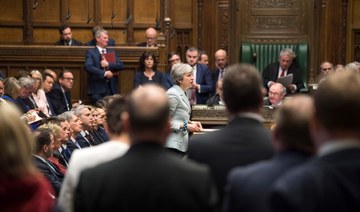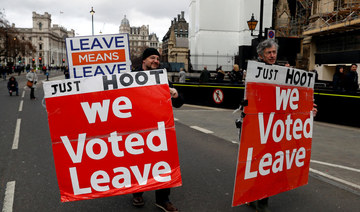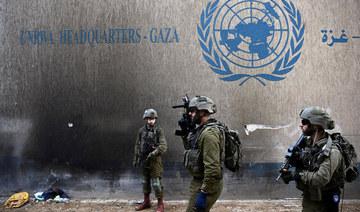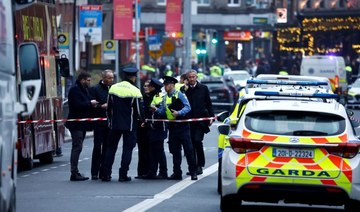LONDON: Prime Minister Theresa May on Wednesday pledged to step down if MPs back her EU divorce deal, in a bid to break the Brexit deadlock in Britain’s fractured parliament.
Following months of pressure, May told her Conservative MPs that she would quit if they see through the withdrawal agreement she painstakingly negotiated with Brussels.
Her dramatic gambit came just two hours before MPs start a flurry of votes seeking a last-minute alternative Brexit plan to replace her deal.
May said she would not lead the country in negotiations on the UK’s future relationship with the European Union once Britain is out of the bloc.
“This has been a testing time for our country and our party. We’re nearly there,” May told the packed closed-door meeting in parliament, according to her Downing Street office.
“I know there is a desire for a new approach — and new leadership — in the second phase of the Brexit negotiations and I won’t stand in the way of that.
“But we need to get the deal through and deliver Brexit. I am prepared to leave this job earlier than I intended in order to do what is right for our country and our party.
“I ask everyone in this room to back the deal so we can complete our historic duty — to deliver on the decision of the British people and leave the European Union with a smooth and orderly exit.”
Three years of political turmoil that followed Britain’s decision to break its near half-century bond with the EU were meant to have ended on Friday with the formal completion of the divorce.
But no clear end is in sight and lawmakers have twice resoundingly rejected the agreement May concluded with Brussels over 17 months of acrimonious talks.
Parliament has decided to try to resolve the crisis by giving itself the right to choose from a variety of alternatives to May’s plan.
It will vote at 1900 GMT on eight options that range from a second referendum to recalling the EU withdrawal notice or leaving under much closer economic terms.
Time has been set aside on Monday for MPs to try and whittle down the most popular options to a final plan.
But the motions are non-binding and it will be tough for parliament to force the government to back any proposal with which it disagrees.
House of Commons Leader Andrea Leadsom, responsible for bringing forward government business, warned that a lot of parliament’s proposals “are just undeliverable.”
She said there was a “real possibility” that May will bring back her deal for a third vote on Thursday or Friday.
But Commons Speaker John Bercow reminded May that he already scuppered her plan to hold a third vote last week because she was effectively bringing back the same rejected text.
“I do expect the government to meet the test of change,” Bercow told the chamber.
EU leaders have given Britain an extended deadline of April 12 to either salvage May’s deal or find a better way.
Failure to do either could result in a no-deal divorce — a scenario that frightens markets and businesses.
If parliament does adopt May’s deal, Britain is headed for the exit door on May 22.
Britain could otherwise seek an even longer extension that puts it in the odd situation of having to take part in European Parliament elections nearly two months after it was supposed to have left.
May will hope none of the alternatives earn majority support and that her own agreement ends up looking like the best option.
She has already won the backing of Jacob Rees-Mogg, who heads the European Research Group of hard Brexiteers in her party that twice voted against the deal.
“I think we’ve got to the point where legally leaving is better than not leaving at all,” he told BBC radio.
European leaders are watching the entire process with concern.
European Council President Donald Tusk urged EU lawmakers on Wednesday to remain open to a long postponement while Britain rethinks its stance.
“We should be open to a long extension if the UK wishes to rethink its Brexit strategy,” he said.
British PM Theresa May promises to quit to save Brexit plan
British PM Theresa May promises to quit to save Brexit plan
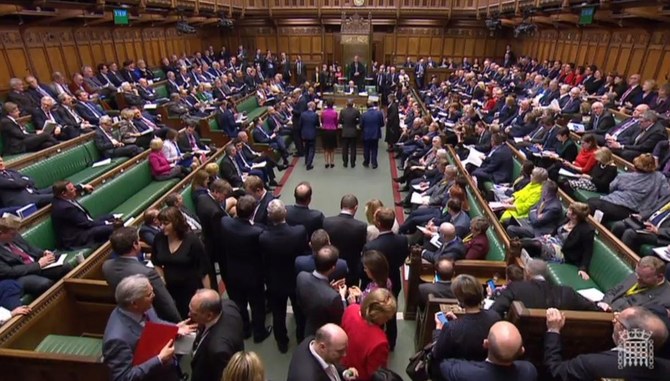
- Lawmakers have twice resoundingly rejected Theresa May's deal
- Parliament voting on eight options ranging from second referendum to recalling EU withdrawal notice
Netherlands remembers World War Two dead amid tight security due to Gaza war
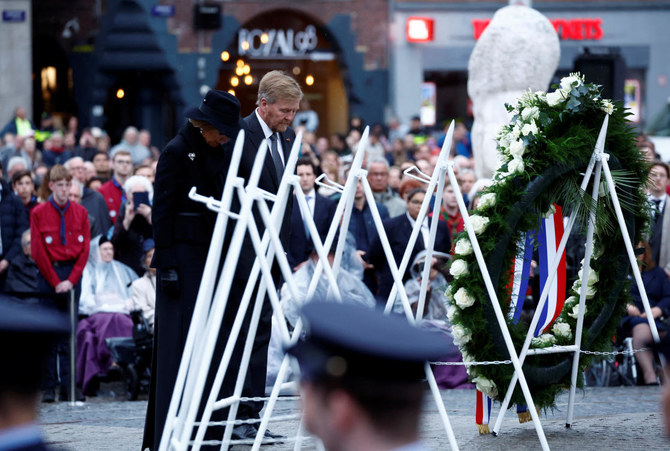
- Normally some 20,000 people attend the Dam commemoration
- Earlier this week municipal authorities announced unprecedented security measures to keep the ceremony safe and avoid possible disruptions linked to the Israel-Hamas war
AMSTERDAM: Dutch King Willem-Alexander and Prime Minister Mark Rutte joined around 4,000 people on Saturday for the country’s annual World War Two remembrance ceremony amid restricted public access and heightened security due to the war in Gaza.
The ceremony on Amsterdam’s central Dam square, with the traditional two minutes of silence at 8 p.m. (1800 GMT) to commemorate the victims of World War Two, passed smoothly despite fears that there might be protests.
Normally some 20,000 people attend the Dam commemoration without having to register. But earlier this week municipal authorities announced unprecedented security measures to keep the ceremony safe and avoid possible disruptions linked to the Israel-Hamas war.
At the opening of a Holocaust Museum in Amsterdam in March, pro-Palestinian protesters opposed to Israel’s military campaign in Gaza set off fireworks and booed Israeli President Isaac Herzog as he arrived on a visit.
Every town and the city in the Netherlands holds its own remembrance ceremony on May 4 and tens of thousands of people attend the events. The Netherlands then marks on May 5 the anniversary of its liberation from Nazi occupation in 1945.
Drone footage shows Ukrainian village battered to ruins as residents flee Russian advance
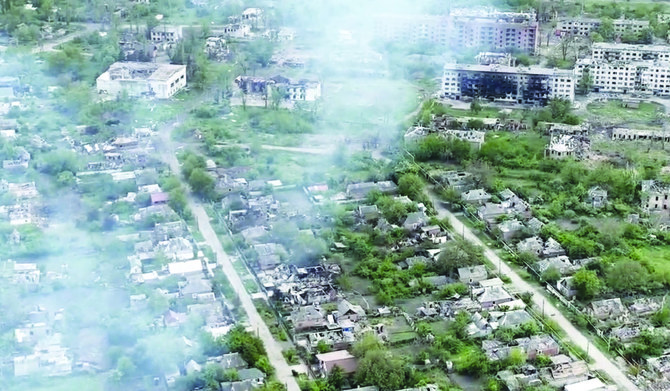
- Residents have scrambled to flee the village, among them a 98-year-old woman who walked almost 10 kilometers (6 miles) alone last week, wearing a pair of slippers and supported by a cane, until she reached Ukrainian front lines
KYIV: The Ukrainian village of Ocheretyne has been battered by fighting, drone footage obtained by The Associated Press shows. The village has been a target for Russian forces in the Donetsk region of eastern Ukraine.
Russian troops have been advancing in the area, pounding Kyiv’s depleted, ammunition-deprived forces with artillery, drones and bombs. Ukraine’s military has acknowledged the Russians have gained a “foothold” in Ocheretyne, which had a population of about 3,000 before the war, but says that fighting continues.
Residents have scrambled to flee the village, among them a 98-year-old woman who walked almost 10 kilometers (6 miles) alone last week, wearing a pair of slippers and supported by a cane, until she reached Ukrainian front lines.
FASTFACT
Ukraine’s military has acknowledged the Russians have gained a “foothold” in Ocheretyne, which had a population of about 3,000 before the war, but says that fighting continues.
Not a single person is seen in the footage, and no building in Ocheretyne appears to have been left untouched by the fighting. Most houses, apartment blocks and other buildings look damaged beyond repair, and many houses have been pummeled into piles of wood and bricks. A factory on the outskirts has also been badly damaged.
The footage also shows smoke billowing from several houses, and fires burning in at least two buildings.
Elsewhere, Russia has in recent weeks stepped up attacks on Kharkiv, Ukraine’s second-largest city, in an attempt to pummel the region’s energy infrastructure and terrorize its 1.3 million residents.
Four people were wounded and a two-story civilian building was damaged and set ablaze overnight after Russian forces struck Kharkiv, in northeastern Ukraine, with exploding drones, regional governor Oleh Syniehubov said Saturday.
The four, including a 13-year-old, were hurt by falling debris, he said on the Telegram messaging app.
Russian state agency RIA reported Saturday reported that Moscow’s forces struck a drone warehouse in Kharkiv that had been used by Ukrainian troops overnight, citing Sergei Lebedev, described as a coordinator of local pro-Moscow guerrillas. His comments could not be independently verified.
Syniehubov said Russia also bombed Kharkiv on Friday, damaging residential buildings and sparking a fire. An 82-year-old woman died and two men were wounded.
Ukraine’s military said Russia launched a total of 13 Shahed drones at the Kharkiv and Dnipropetrovsk regions of eastern Ukraine overnight, all of which were shot down by Ukrainian air defenses.
Students in Ireland, Switzerland join the protest wave over Gaza
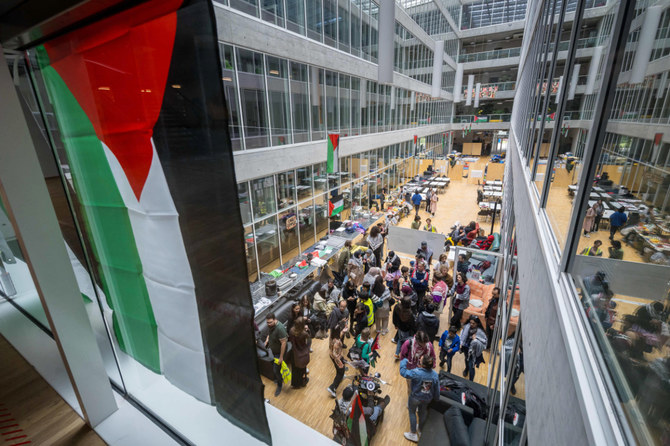
- Dublin students build encampment, forcing university to restrict campus access and close Book of Kells exhibition
- Israel has killed more than 34,000 Palestinians in Gaza, mostly women and children, according to the health ministry in the Hamas-run territory
DUBLIN: Students at Trinity College Dublin and Lausanne University in Switzerland have staged occupations to protest against Israel’s war in Gaza, joining a wave of demonstrations sweeping US campuses.
In Dublin, students built an encampment on Friday, forcing the university to restrict campus access on Saturday and close the Book of Kells exhibition, one of Ireland’s top tourist attractions.
The camp was set up after the students’ union said the university had fined it €214,000 ($230,000) for losses caused by protests in recent months, not exclusively over Gaza.
The protesters were demanding that Trinity cut academic ties with Israel and divest from companies with ties to Israel.
BACKGROUND
The protesters were demanding that Trinity College Dublin cut academic ties with Israel and divest from companies with ties to Israel.
Students’ union president Laszlo Molnarfia posted a photograph of benches piled up at the entrance to the building housing the Book of Kells, an illuminated manuscript created by Celtic monks in about 800 AD.
Trinity College said it had restricted access to students, staff, and residents to ensure safety and that the exhibition would be closed on Saturday.
More than 34,600 Palestinians have been killed in Israel’s seven-month-old assault on the Gaza Strip, say health officials in the enclave.
The war began when Hamas militants attacked Israel on Oct. 7.
Pro-Palestinian protests have also been held at universities in Australia and Canada.
In Lausanne, around 100 students occupied a building to back demands, including an end to scientific cooperation with Israel.
“Palestinians have been dying for over 200 days, but we are not being heard,” one protester told Swiss television on Saturday.
“There’s a global movement to get governments to take action, but it’s not happening. That’s why we want to get universities involved now.”
The university said the occupation could continue until Monday, provided it did not disrupt work on campus.
“We universities are not called upon to take political stands,” the university’s rector, Frederic Herman, told RTS radio.
Last week, the head of Trinity College, Linda Doyle, said it was reviewing its investments but that it was for individual academics to decide whether to work with Israeli institutions.
Sadiq Khan, Pakistani immigrant bus driver’s son, makes history by winning third term as London mayor
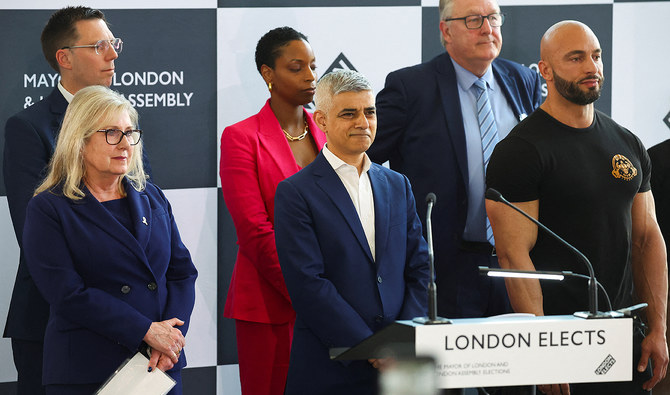
- Khan, an official with global renown, became the first Muslim mayor of a Western capital when elected in 2016
- Born in London in 1970, he grew up in public housing the Tooting area and slept in a bunk-bed until he was 24
LONDON: Sadiq Khan, who was Saturday re-elected for a record third term as London mayor, rose from humble roots to spar with world leaders and bring consequential change to the British capital.
The 53-year-old Labor party politician – a former human rights lawyer brought up on a London public housing complex – comfortably defeated Conservative rival Susan Hall for a third stint at City Hall.
He now overtakes predecessor Boris Johnson as the longest-serving holder of the post, which notably has powers over the emergency services, transport and planning in the city of nearly nine million.
Victory continues a remarkable journey for the Pakistani immigrant bus driver’s son, who became the first Muslim mayor of a Western capital when initially elected in 2016.
As mayor, he has made a name for himself as a vocal critic of Brexit and successive Conservative prime ministers, including Johnson, as well as for a feud with former US president Donald Trump.
The pair became embroiled in an extraordinary war of words after Khan criticized Trump’s travel ban on people from certain Muslim countries.
Trump then accused Khan of doing a “very bad job on terrorism” and called him a “stone cold loser” and a “national disgrace.”
The mayor in turn allowed an infamous blimp of Trump dressed as a baby in a nappy to fly above protests in Parliament Square during his 2018 visit to Britain.
“He once called me a stone cold loser. Only one of us is a loser, and it’s not me,” Khan told AFP during his 2021 campaign.
But Khan’s own tenure has not been without its controversies, particularly over last year’s expansion of an Ultra-Low Emission Zone into the largest pollution-charging scheme in the world.
The daily toll on the most-polluting vehicles prompted a fierce backlash in outer boroughs of Greater London, with anger at the extra financial burden during a cost-of-living crisis.
Khan has also been criticized for failing to get to grips with high levels of knife crime and since last year, his handling of large weekly pro-Palestinian protests.
Born in London in 1970 to parents who had recently arrived from Pakistan, Khan was the fifth child out of seven brothers and one sister.
He grew up in public housing in Tooting, an ethnically mixed residential area in south London, and slept in a bunk-bed until he was 24.
His modest background plays well in a city that is proud of its diversity and loves a self-made success story.
Khan still regularly recalls how his father drove one of London’s famous red buses, and his mother was a seamstress.
He is a handy boxer, having learnt the sport to defend himself in the streets against those who hurled racist abuse at him, and two of his brothers are boxing coaches.
He initially wanted to become a dentist, but a teacher spotted his gift for verbal sparring and directed him toward law.
He gained a law degree from the University of North London and started out as a trainee lawyer in 1994 at the Christian Fisher legal firm, where he was eventually made a partner.
He specialized in human rights, and spent three years chairing the civil liberties campaign group Liberty.
He represented Louis Farrakhan, leader of the Nation of Islam movement, and Babar Ahmad, a mosque acquaintance who was jailed in the United States after admitting providing support to the Taliban regime in Afghanistan.
Khan joined Labor aged 15 when Conservative prime minister Margaret Thatcher was in her pomp.
He became a local councilor for Tooting in the Conservative-dominated Wandsworth local borough in 1994, and its member of parliament in 2005.
He still lives in the area with his lawyer wife Saadiya and their two teenage daughters.
Labor prime minister Gordon Brown made him communities minister in 2008 and he later served as transport minister, becoming the first Muslim minister to attend Cabinet meetings.
In parliament, he voted for gay marriage – which earned him death threats.
As mayor, he vowed to focus on providing affordable homes for Londoners and freezing transport fares, but – like many in power around the world – saw his agenda engulfed by the pandemic.
He is London’s third mayor after Labor’s Ken Livingstone (2000-2008) and Johnson (2008-2016), with widespread speculation he could eventually try to follow in his predecessor and become prime minister.
Cyclone bears down on flood-hit Kenya, Tanzania
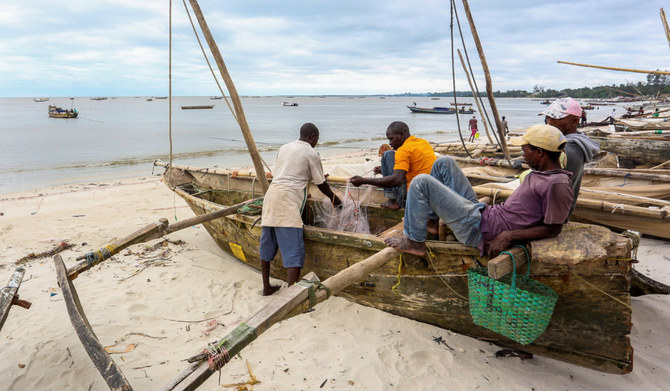
- The two East African neighbors are still recovering from last weeks devastating floods
- Kenya reported about 200 dead while Tanzaia said at least 155 died in floods and landslides
NAIROBI: Beaches were deserted and many shops closed on Saturday as heavy rains and winds from a tropical cyclone buffeted coastal areas of Tanzania and Kenya.
Both countries have gone on alert for Tropical Cyclone Hidaya, after weeks of torrential rains and floods that have wreaked havoc in many parts of East Africa and claimed more than 400 lives.
But there were no reports of casualties or damage as of Saturday afternoon as the cyclone rolled in from the Indian Ocean and made landfall in Tanzania.
“It’s so strange today to see only few people at the beach. We are used to seeing crowds, especially during the weekend,” said Yusuf Hassan, a resident of Tanzania’s main city Dar es Salaam.
“But I am sure people are afraid of the cyclone.”
The Kenya Meteorological Department said the cyclone was already being felt offshore, with strong winds exceeding 40 knots and waves of over two meters (over six feet).
It forecast heavy rainfall along the coast from Sunday, intensifying over the following two days, but said Kenya would only feel the effects of the cyclone from the “fringes” because of its location on the equator.
Interior Minister Kithure Kindiki announced a ban on all beach activities, swimming and fishing.
The Tanzanian Meteorological Authority said there had been strong winds and heavy downpours along the coast overnight.
In the Mtwara area, it said over 90 millimeters (3.5 inches) of rain had been reported in 24 hours, nearly twice the average May rainfall of 54 millimeters.
The agency advised people living in risk-prone areas and those involved in marine activities to take “maximum precautions.”
In the Zanzibar archipelago, all marine transport has been suspended.
“We believe it’s not safe to travel under such weather conditions caused by the cyclone,” Zanzibar Maritime Authority director general Sheikha Ahmed Mohamed told AFP.
Cyclone season in the southwest Indian Ocean normally lasts from November to April and there are around a dozen storms each year.
Kenyan President William Ruto on Friday described the weather picture as “dire” and postponed the reopening of schools indefinitely, with the approach of what he said was the nation’s first-ever cyclone.
Around 210 people have died in Kenya from flood-related incidents and nearly 100 are missing.
A further 165,000 have been forced to flee their homes, according to government data.
“No corner of our country has been spared from this havoc,” Ruto said in a televised address, blaming the devastating cycle of drought and floods on a failure to protect the environment.
“Sadly, we have not seen the last of this perilous period.”
On Thursday, the interior ministry ordered anyone living near major rivers or dams to leave the area within 24 hours or face “mandatory evacuation for their safety.”
It warned that 178 dams and reservoirs were at risk of spilling over.
Kindiki said 138 camps have been set up to offer temporary shelter to more than 62,000 people displaced by floodwaters.
Opposition politicians and lobby groups have accused the government of being unprepared and slow to respond despite weather warnings.
At least 155 people have also been killed in Tanzania by floods and landslides that have swallowed homes and destroyed crops.
East Africa is highly vulnerable to climate change and this year’s rains have been exacerbated by El Nino — a climate phenomenon typically associated with increased heat that leads to drought in some parts of the world and heavy downpours elsewhere.
Torrential rains have claimed at least 29 lives in Burundi since September, while weather-related deaths have also been reported in Ethiopia, Rwanda, Somalia and Uganda.
Late last year, more than 300 people died in rains and floods in Ethiopia, Kenya and Somalia, just as the region was trying to recover from its worst drought in four decades.



